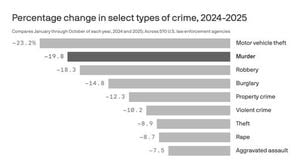In a series of headline-grabbing moves this November, the Trump administration has once again reshaped the nation’s energy landscape—this time, by overturning key environmental protections and putting both renewable and fossil fuel projects under the microscope. Two major federal decisions, handed down just days apart, have sent ripples through the energy sector, environmental advocacy groups, and communities from New England to the Arctic Circle.
On November 4, 2025, the US District Court for the District of Columbia ruled in favor of the US Department of the Interior, granting the Bureau of Ocean Energy Management (BOEM) the authority to revoke construction and operations plans for a massive offshore wind farm straddling the coasts of Massachusetts and Rhode Island. According to reporting by Expose the Heist: Power and Policy in Unprecedented Times, this legal victory for the administration comes after months of mounting pressure and a contentious executive order. That order, issued after BOEM’s initial approval of the wind project in January, mandated a sweeping review of existing wind energy leases—effectively throwing the fate of several high-profile renewable projects into limbo.
The project in question, managed by Southcoast Wind Energy LLC, had already seen $600 million in investment, as confirmed by Michael Brown, CEO of Ocean Winds, the company’s parent. The Town and County of Nantucket had filed suit against BOEM in March, alleging that the agency’s environmental review was rushed and insufficient. In September, the federal government requested a pause on the legal proceedings to conduct its own review. Judge Tanya Chutkan’s November 4th ruling clarified the government’s authority, stating, “An agency does not need a remand to reconsider a challenged rule—it can do so at any time, including while challenges are pending.” She further noted that Southcoast Wind Energy LLC was not “likely to suffer immediate and significant hardship” from the project’s pause.
But the uncertainty doesn’t end there. BOEM is also seeking to reverse its approval for two other major offshore wind initiatives: the Maryland Offshore Wind project, set to begin operations next year, and the New England Wind project. These moves have cast a shadow over the country’s nascent offshore wind industry and left developers, investors, and local officials scrambling for answers.
Meanwhile, just two weeks later and thousands of miles away, the Department of the Interior finalized a rule on November 19, 2025, overturning restrictions imposed during President Joe Biden’s administration that had sharply limited oil and gas drilling across Alaska’s National Petroleum Reserve (NPR-A). As reported by Petroleum Australia, the decision marks a monumental shift in federal energy policy, aligning squarely with President Donald Trump’s push to expand domestic fossil fuel production and reduce regulatory hurdles for energy developers.
The Biden-era rules, enacted in 2024, had prohibited new leasing for oil and gas extraction across 10.6 million acres of the NPR-A—an expanse roughly the size of Iceland—and imposed further constraints on more than two million additional acres. These measures were part of the broader “America the Beautiful” initiative, which aimed to protect 30 percent of US lands and waters by 2030 in response to the growing threat of climate change. Environmental groups hailed the restrictions as crucial for safeguarding sensitive Arctic habitats and curbing carbon emissions linked to oil production.
But not everyone was on board. Alaska state officials and industry representatives blasted the restrictions as a blow to economic development, warning of job losses and increased reliance on imported energy. According to Reuters, critics argued that the 2024 rule threatened the economic lifeblood of the state, where local and state revenues are heavily dependent on oil taxes and royalties. The Voice of the Arctic Inupiat, representing North Slope communities, supported the Trump administration’s reversal, emphasizing that oil infrastructure delivers essential tax revenue for education, healthcare, and public services in remote areas.
Interior Secretary Doug Burgum, in a statement accompanying the new rule, said, “By rescinding the 2024 rule, we are following the direction set by President Trump to unlock Alaska’s energy potential, create jobs for North Slope communities and strengthen American energy security.” The Department of the Interior elaborated that the updated rule would “strengthen American Energy Dominance and reduce reliance on foreign oil,” echoing Trump’s long-standing energy independence mantra.
Environmental organizations, including the Natural Resources Defense Council (NRDC), have fiercely condemned the decision. They argue it undermines progress toward reducing emissions and protecting fragile Arctic ecosystems, home to caribou, polar bears, and migratory birds. The NPR-A, at 23 million acres, is the largest federally managed land area in the United States and a critical wildlife refuge as well as a significant oil reserve.
The policy turnaround in Alaska follows other notable energy decisions by the Trump administration, including the cancellation of plans to auction offshore oil and gas leases along the US East Coast earlier in 2025. That move, interestingly, came after Republican leaders in several southern states voiced environmental and tourism concerns—showing that the energy debate doesn’t always break cleanly along party lines.
Back in the lower 48, the push and pull between renewable energy and fossil fuels continues to play out in public opinion and market trends. According to a June 2025 Pew Research Center poll cited by Expose the Heist, 77 percent of US adults favor expanding solar power and 68 percent support more wind power, with 60 percent saying that growing renewable energy is more important than expanding fossil fuels. Support for oil, gas, and coal lags behind, with only 39 percent of adults approving of increased fossil fuel production. Despite this, Republican voters have shifted dramatically against clean power in recent years, fueling political battles over energy policy.
Market forces, meanwhile, seem to be moving inexorably toward renewables. The Institute for Energy Economics and Financial Analysis projects that the US will shutter half of its coal-fired power generation capacity by 2026, a contraction driven by economics rather than politics. Even as the Trump administration seeks to bolster fossil fuels, the long-term trajectory appears to favor wind and solar—at least according to current trends and consumer preferences.
Yet, as these latest decisions show, federal policy can still deliver sharp jolts to the energy sector. The revocation of wind farm plans off New England’s coast and the reopening of millions of acres in Alaska for oil and gas exploration have left both industries in a state of flux. Developers and investors face uncertainty, while communities weigh the promise of jobs and revenue against environmental risks and the specter of climate change.
As the dust settles, one thing is clear: America’s energy future remains fiercely contested, with high stakes for the economy, the environment, and the nation’s place in the global energy race.





